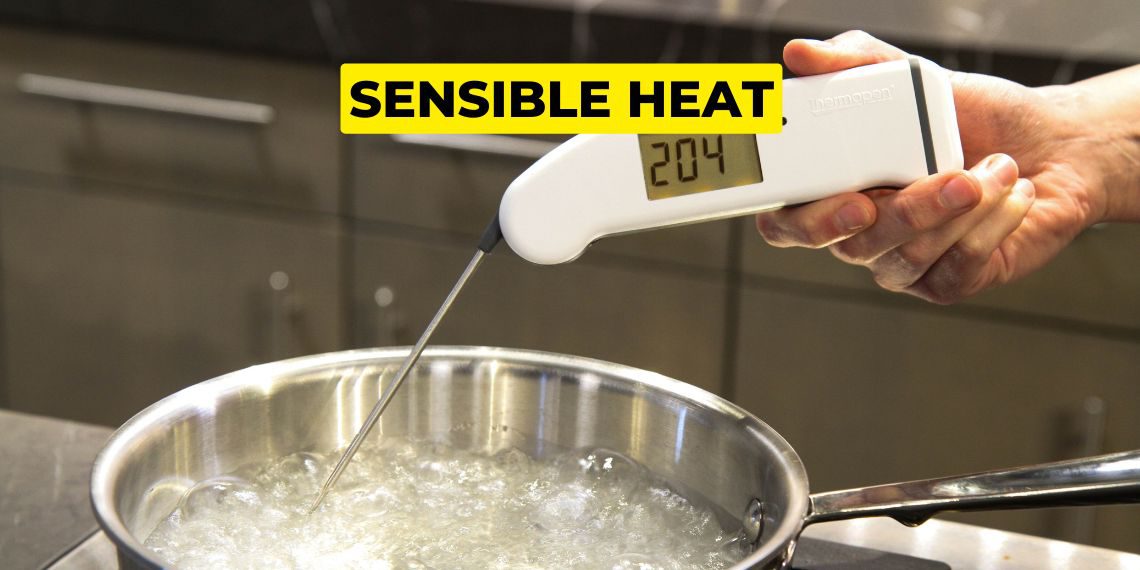What is sensible heat and latent heat?
Sensible heat:

Sensible heat is the amount of heat required to change the temp of a substance without changing the state. When heat is applied to an object and it causes the temperature of the object to increase it is known as sensible heat.
Sensible heat can be added or removed from a substance without changing its phase (i.e., without causing it to melt, evaporate, or freeze).
Latent heat:

Latent heat is the hidden heat. It is the amount of heat required to change the state of a substance at a constant temperature.
Latent heat of fusion:
It is the amount of heat required to change the state of 1 gm of ice to liquid at melting point without changing the temperature.
When 0℃ ice is heated it changes into 0℃ water, where the heat is added to ice but its temperature remains the same. The heat absorbed here without a change in temperature is known as the latent heat of fusion.
Latent heat of fusion is 80 cal/gm.
Latent heat of vapourisation:
It is the amount of heat required to change the state of 1 gm of liquid to vapour at boiling point without changing its temperature.
If we take 100℃ water and start boiling, it will be changing its state at 100℃ at 1 bar atmospheric pressure into 100℃ vapour and steam and the heat absorbed during this period is known as latent heat of vaporisation.
Latent heat of vaporisation is 540 cal/gm.
Heat capacity:
The amount of heat required to increase the temperature of an amount of liquid or water by 1℃ is called heat capacity.
For example; 10 litre water temperature is 10℃ and we give heat to increase the water temperature to 11°C. For increasing the temperature how much heat is required is called heat capacity.

Specific heat capacity:
Amount of heat required to raise the temperature of unit mass (1 gm) by 1 degree is called specific heat capacity.
For example; 1 kg of water in 10℃, gives heat and increases its temperature to 11°C, how much heat is absorbed to increase this 1℃ temperature of the 1gm water is called specific heat capacity.
Q =m x c x ΔT
m x c = heat capacity

Saturated steam:
The steam that has the same temperature as water is known as saturated steam.
When we heat water its temperature rises to its boiling point. When we add more heat the water vaporises and steam is formed.

Saturated pressure and temperature:
The temperature and pressure at which a substance changes its state are called saturated temperature and pressure.
For example, at 100℃ at 1 bar atmospheric pressure heating water and converting its state from liquid to vapour. On the other hand when 100℃ steam converts back into water that is also a saturation point.
Dry saturated steam:
When water is heated to its boiling point and further heat is added to vapourize water and steam is produced. The steam that has no water content in it is known as dry saturated steam.
Wet steam:
The steam that has water content in is known as wet steam.
It is a two phase content- both water droplets that have not changed state yet and steam.
If it is said that the dryness factor is 0.8 that means 20% of water vapour is present at saturated temperature.

Superheated steam:
If we further heat dry saturated steam it will increase the temperature from its boiling point and form superheated steam.
Whatever temperature above boiling point is known as superheated steam.
Note:
If you want to learn more about this topic, we suggest checking out our Combo package with the given link https://merchantnavydecoded.com/courses/c/ . It’s a great way to dive deeper into the subject through video explanations. This package covers all the important details and presents them in an easy-to-understand format. Watching the videos will help you grasp the topic better and make learning more enjoyable. So, we highly recommend giving our Combo package a try to enhance your knowledge on the subject.
Disclaimer :- The opinions expressed in this article belong solely to the author and may not necessarily reflect those of Merchant Navy Decoded. We cannot guarantee the accuracy of the information provided and disclaim any responsibility for it. Data and visuals used are sourced from publicly available information and may not be authenticated by any regulatory body. Reviews and comments appearing on our blogs represent the opinions of individuals and do not necessarily reflect the views of Merchant Navy Decoded. We are not responsible for any loss or damage resulting from reliance on these reviews or comments.
Reproduction, copying, sharing, or use of the article or images in any form is strictly prohibited without prior permission from both the author and Merchant Navy Decoded.



